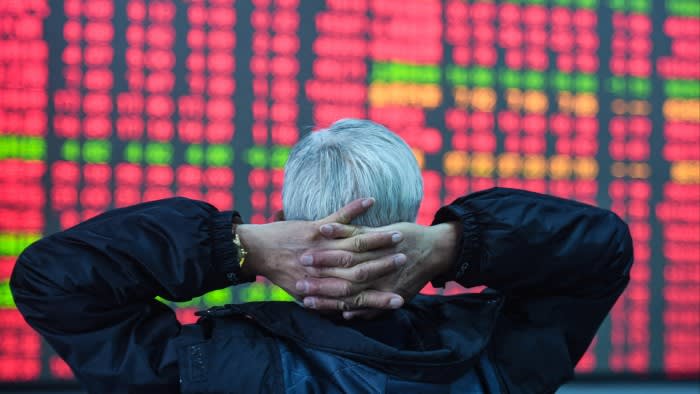After China’s stock markets went on a record-breaking rally in recent weeks, police in Jiangxi province posted video footage online of a driver parked for hours in a highway emergency lane. His excuse for not heeding multiple warnings from other drivers: he was too caught up in trading shares.
The driver was not the only one flirting with danger. Millions of other Chinese have been similarly glued to their screens and brokerage accounts in past days as markets have soared — then plummeted — in days of volatile trading.
Small investors rushed into a vertiginous market rally that started in late September, when China’s central bank announced measures to pep up equity and property markets. The benchmark CSI 300 index rose 24 per cent in five trading days, then reopened 11 per cent higher following a week-long holiday.
But within hours — after other Beijing policymakers failed to fulfil investor expectations of an announcement of deeper fiscal stimulus — a record-breaking rally slid into the biggest one-day fall in more than four years.
The sudden burst of activity marks a notable return of animal spirits to China’s retail trading crowd, after many small traders had fled the underperforming stock market and sought out assets such as gold and government debt.
But the wild market swings also underscore the risks of a headlong dash back into China’s volatile equities, with some using the phrase ge jiucai, meaning “cutting leeks” — a reference to investment newcomers who rush in at the top of the market only to be scythed down.
“If people are trying to make quick money right now, inexperienced investors are bound to suffer losses,” said a man who gave his name as Mou, a 43-year-old from Kunming who has been investing for 20 years.

Still, the rush back into stocks has been pronounced. Retail buying spiked after the stimulus was announced on September 24, with almost Rmb3tn ($424bn) of buying on October 8 alone, according to Wind, a data provider. The number of new margin trading investors — who need more than Rmb500,000 to invest — surged by 30,000 over six trading days, according to a sentiment tracker by Goldman Sachs.
Brokers told the Financial Times they were working flat out to sign up huge numbers of new clients.
“A client contacted me at 1:40am yesterday to open a securities account,” a Shanghai-based account manager for one mid-sized brokerage said on Thursday. “Our office phone rings again as soon as I put it down.”
China’s roughly 200mn retail investors have long commanded disproportionate control over the country’s equity markets, as those with funds to invest have very limited opportunities to do so abroad. Authorities in January further restricted the Qualified Domestic Institutional Investor scheme that allowed some retail investors to buy assets abroad.
Retail investors, who invest via brokerages or share accounts, held 55 per cent of the free float of mainland Chinese equities, known as A-shares, at the end of the second quarter, according to calculations by Huaxi Securities. The figure excludes those holding shares via mutual funds.
Nevertheless many Chinese investors have not relied on putting much of their wealth into equities, preferring real estate, bonds and money market funds over riskier stocks.
International industry experts said getting more ordinary investors to commit to the stock market could transform the investment landscape.
“Today [there] exists [roughly] $12tn household deposits stuck in low-yielding money market funds”, said Beeneet Kothari, chief executive of US-based hedge fund Tekne Capital.
“The ongoing capital markets reform momentum and reconfiguration of the real estate industry will drive household asset reallocation,” he added. “This sum total inflow to the China equity markets would represent more than 350 per cent of today’s A-share total free-float market cap.”
Still, many in China recall what happened in 2015 when the Shanghai index reached a historic peak in June before plunging by almost 40 per cent in a month. Both the bull run and the crash that followed were heavily influenced by policy announcements.
One Hangzhou-based private equity fund manager said he capitalised on the “bull run signal” from the central bank briefing in September, but subsequently cut his position in equities from nearly 100 per cent to about 40 per cent when policies to boost fiscal spending failed to materialise.
“I would only add more after I see new promises from the Ministry of Finance on more stimulus, or improvement of high frequency data in October,” he said.
His plans, and those of others, may depend on a finance ministry special briefing due on Saturday. The ministry has said it will focus on “intensifying countercyclical adjustment of fiscal policy”, which economists believe could point to more stimulus measures.
A banker from Anhui province suggested the measures would not lead to a lasting benefit. “This makes the whole world see how good the Chinese stock market is and how prosperous the Chinese economy appears, but in the end, it’s all about cutting leeks. And who gets cut? The small Chinese retail investors,” the banker said.
Penny Gao, a 33-year-old stage manager from Beijing with a mutual fund, is giving up the thought of investing more.
For her, the recent rally has given her what she has sought for three years: a chance to sell out, after the rally allowed her to cut her losses from 40 per cent to a more manageable 20 per cent.
“I don’t want to be trapped again for so long,” she said. “I want to cash out before I turned greedy again.”
Additional reporting by Wang Xueqiao in Shanghai
https://www.ft.com/content/7e7fbf9e-b787-479e-bfcd-f5d9f3908d29


